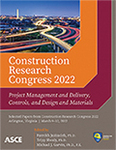Upstream Digitized Materials Tracking by Vendors and Suppliers—Barriers, Drivers, and Benefits
Publication: Construction Research Congress 2022
ABSTRACT
Materials tracking by means of auto-identification technologies has been limited to the semi-automation of onsite materials management. Thus, an opportunity to leverage the use of identification and information technologies by materials vendors and suppliers, i.e., upstream materials tracking, is yet to be explored. In response, this study aims at characterizing the unexplored facet of upstream tracking by vendors and suppliers and explaining its barriers and drivers. A survey instrument was designed to determine the current state of materials tracking readiness, digitization barriers, and opportunities. In total, 50 survey responses were obtained. In addition, remarkable case studies on upstream tracking were characterized through the qualitative analysis of semi-structured interviews with a pre-qualified sample of 13 subject matter experts. Drivers, benefits, and barriers associated with upstream tracking were identified and characterized. For example, a lack of clear return on investment stands a prevailing barrier against the adoption of upstream tracking at every key stakeholder organization, i.e., owners, contractors, and vendors/suppliers. In addition, a disassociation between the fabrication or manufacturing information status of a material component and the physical tracking of such component was characterized as a fundamental difference from onsite tracking practices.
Get full access to this article
View all available purchase options and get full access to this chapter.
REFERENCES
Baldwin, A. N., Thorpe, A., and Alkaabi, J. A. 1994. “Improved materials management through bar-coding: results and implications from a feasibility study.” P. I. Civil Eng.-Civ. En., 102(4), 156–162.
Bisio, I., Sciarrone, A., and Zappatore, S. 2016. “A new asset tracking architecture integrating RFID, Bluetooth Low Energy tags and ad hoc smartphone applications.” Pervasive Mob. Comput., 31, 79–93.
Caldas, C. H., Grau, D., and Haas, C. T. 2006. “Using global positioning system to improve materials-locating processes on industrial projects.” J. Constr. Eng. Manag., 132(7), 741–749.
Caldas, C. H., Menches, C. L., Reyes, P. M., Navarro, L., and Vargas, D. M. 2015. “Materials management practices in the construction industry.” Pract. Period. Struct. Des. Constr., 20(3): 04014039.
CII (Construction Industry Institute). 2012. “Materials management planning guide.”, The University of Texas at Austin, Austin.
Ergen, E., Akinci, B., East, B., and Kirby, J. 2007a. “Tracking components and maintenance history within facility utilizing radio frequency identification technology.” J. Comput. Civ. Eng., 21(1), 11–20.
Ergen, E., Akinci, B., and Sacks, R. 2007b. “Tracking and locating components in a precast storage yard utilizing radio frequency identification technology and GPS.” Autom. Constr., 16(3), 354–367.
Grau, D., Caldas, C. H., Haas, C. T., Goodrum, P. M., and Gong, J. 2009. “Assessing the impact of materials tracking technologies on construction craft productivity.” Autom. Constr., 18(7), 903–911.
Grau, D., Zeng, L., and Xiao, Y. 2012. “Automatically tracking engineered components through shipping and receiving processes with passive identification technologies.” Autom. Constr., 28,36–44.
Jaselskis, E. J., and El-Misalami, T. 2003. “Implementing radio frequency identification in the construction process.” J. Constr. Eng. Manag., 129, 680–688.
Lin, Y.-C., Su, Y.-C., and Chen, Y.-P. 2014. “Developing mobile BIM/2D barcode-based automated facility management system.” Sci. World J., 2014: 374735.
Lotlikar, T., Kankapurkar, R., Parekar, A., and Mohite, A. 2013. “Comparative study of barcode, QR-code and RFID system.” Int. J. Comput. Technol. Appl., 4(5), 817–821.
Lu, W., Huang, G. Q., and Li, H. 2011. “Scenarios for applying RFID technology in construction project management.” Autom. Constr., 20, 101–106.
Park, J., Kim, K., and Cho, Y. 2017. “Framework of automated construction-safety monitoring using cloud-enabled BIM and BLE mobile tracking sensors.” J. Constr. Eng. Manag., 143(2): 05016019.
Ren, Z., Anumba, C. J., and Tah, J. 2011. “RFID-facilitated construction materials management (RFID-CMM) – A case study of water-supply project.” Adv. Eng. Inform., 25(2), 198–207.
Song, J., Haas, C. T., and Caldas, C. H. 2006. “Tracking the location of materials on construction job sites.” J. Constr. Eng. Manag., 132(9), 911–918.
Won, D., Chi, S., and Park, M. 2020. “UAV-RFID integration for construction resource localization.” KSCE J. Civ. Eng., 24(6), 1683–1695.
Xiao, S., Yu, S., Wu, K., Ni, Q., Janecek, C., and Nordstad, J. 2007. “Radio frequency identification: technologies, applications, and research issues.” Wirel. Commun. Mob. Comput., 7(4), 457–472.
Zhao, J., Seppänen, O., Peltokorpi, A., Badihi, B., and Olivieri, H. 2019. “Real-time resource tracking for analyzing value-adding time in construction.” Autom. Constr., 104, 52–65.
Information & Authors
Information
Published In
History
Published online: Mar 7, 2022
Authors
Metrics & Citations
Metrics
Citations
Download citation
If you have the appropriate software installed, you can download article citation data to the citation manager of your choice. Simply select your manager software from the list below and click Download.
